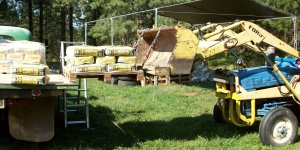LD1
Epic Contributor
My loader is rated at 860# at bucket edge, 1000# bucket center and 1150# at the pins.
I have lifted 1100#+ on clamp on forks with the load centered 20"+/- in front of the edge.
Underrated...maybe. But published spec is max height too.
To my knowledge, deere is the only one that publishes a spec to a height of 59" as well as max height. The 59" number is always alot more.
My loader manual has a graph that has the curve of lift capacity vs height. IIRC the max at the pins near ground level is somewhere around 2k
I have lifted 1100#+ on clamp on forks with the load centered 20"+/- in front of the edge.
Underrated...maybe. But published spec is max height too.
To my knowledge, deere is the only one that publishes a spec to a height of 59" as well as max height. The 59" number is always alot more.
My loader manual has a graph that has the curve of lift capacity vs height. IIRC the max at the pins near ground level is somewhere around 2k

